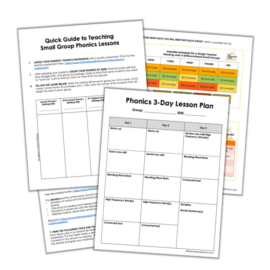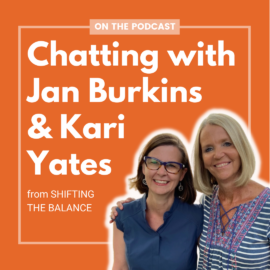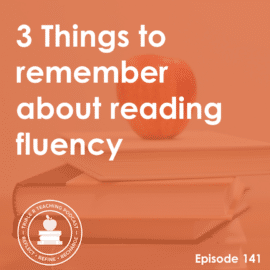
TRT Podcast#71: How to plan and teach small group phonics lessons
How should you form your phonics groups? How often should you meet with each group? What specific activities should you include in your lessons? We’ve got the answers in this week’s episode!
Listen to the episode here
Full episode transcript
Hello, hello! Anna Geiger here from The Measured Mom, and today we're going to talk about how to form your small phonics groups, how to schedule your meetings with those groups, and what to do when you're meeting with the group. We're basically looking at the nuts and bolts. We're really dialing in to see how we're going to apply all the things you've learned about the science of reading and structured literacy to your day-to-day teaching.
I know we sometimes get really excited by all the things we get to learn, but when it comes down to actually applying it, it gets very tricky, so I want this to be a really practical episode for you. Please remember that anything I'm sharing can be found in the show notes, themeasuredmom.com/episode71. You're definitely going to want to head there because there's a lot of useful links and materials you're going to find.
Now, first thing, why small groups? Why can't we just teach the on-level phonics skill to the whole class? While plenty of teachers do this, it is not my preference because your students, as you know, are at so many different levels. What some teachers do is they teach the on-level skill to the whole class, and then they differentiate in small groups, maybe they meet with kids who are struggling and give them extra support.
But to me, it doesn't make sense if you have someone who is still struggling to read CVC words, but then you're trying to teach them long vowel teams with the whole class. To me, it makes more sense to meet with them in a small group with other kids who are struggling with the same skill so they can get lots of practice on that skill.
I also don't like the idea of having kids who are advanced in their phonics skill being part of a lesson every day that's something far beneath what they're capable of. I would much rather see those students challenged in more advanced phonics skills, multisyllable words, and so on.
In their book "How to Plan Differentiated Reading Instruction," Sharon Walpole and Michael McKenna promote this model where you assess students and then you group them by their needs and that's their main instruction. Their main instruction is not whole class, it's in these small groups. They said that the benefit of this approach is that "no students who have already mastered foundational skills for their grade level will receive redundant time-wasting instruction."
This was brought up in a Facebook group I was a part of, and someone said, "Is it really so bad to be bored for twenty minutes a day?" But I don't think that's the point. I think the point is that we're not giving them what they need. They don't need the same thing over and over that they've mastered at least a year ago. They need to be challenged and move into the next stage of phonics knowledge.
That's my philosophy, I do think it's important to group students by level. First, you're going to give them a phonics assessment. I have one free on my website and I will link to that in the show notes, themeasuredmom.com/episode71. After you've given that assessment, you're going to look at the results and group your students into four groups.
Now, you're going to look at the results and you're going to want to group your students into ten groups because they're going to be all over the place, it's not going to be evenly divided. It's okay though to have some students move back a little bit to review. It's still, when you think about it, way better for them than having them be doing the same skill with the whole class. The groups will not be perfect, that's not possible, but you're going to be doing a much better job than if you're teaching everyone the same thing every day.
The reason I recommend having just four groups is that you'll be able to meet with them enough times per week to make a difference. If you have too many groups, you're not going to be able to see your advanced readers very often. We want everyone to be meeting with you as much as possible, so I recommend meeting with three groups per day, each group for twenty minutes. Fifteen minutes is a little short, and I think you'll find yourself stressed out if you try to do it in fifteen. Thirty minutes would be awesome, but that's really unrealistic because then you're trying to keep the rest of the kids busy and engaged while you're meeting with a small group.
Now, if you're in a really ideal situation where you have other teachers of your grade level doing the same approach that you are, one teacher could do the lowest level group, one could do the next highest, and so on all at the same time. If you did that, you could meet with all the students every day, but I totally understand that that's not realistic. So assuming you're not in that really exciting situation and you're doing all the teaching, I would meet with three groups per day, twenty minutes per group.
Now, you might be thinking, "Okay, but we have four groups. How does that work?"
Here's what I recommend. I recommend meeting with your lowest group every day. In fact, I would just start always with them so they know when phonics time starts, they go to the table. It's a routine they can get used to.
After that, I would recommend meeting with your next lowest group four days a week. One of those days you're not going to see them, maybe on Wednesday, but they meet with you four days a week.
Then you're going to meet with your second highest group three times a week and your highest group also three times a week.
I actually have a visual chart that would show you how this could look. I'll put it in the show notes for the episode, themeasuredmom.com/episode71.
Now the question is, "Okay, I've got these groups, and I know the skills I'm going to teach them, but what do I do with them in those twenty minutes?"
That is a really good question, and I want you to know that in the show notes, you're going to find a link to a PDF where I'm going to give you a layout of what those lessons could look like and what things you could do within those twenty minutes. I'm going to go through it right now also, but you don't need to write this down, just make sure you check the show notes at the end of the episode, themeasuredmom.com/episode71.
So let's say that you teach each skill for three days. That means that your lowest group is going to get through one skill a week plus two parts of another, whereas your highest groups are only going to get through one new skill each week. That's totally fine. They're advanced, and they're probably going to learn much faster. You could maybe move ahead and get to another skill sooner than you might think or it's okay because they are far above grade level and they're going to be doing just fine. But you can see that in giving more instruction to your lowest readers, they have a better chance of getting up to grade level.
In those lessons, the first day of the new skill, you're going to do some kind of warm-up. A warm-up could include a visual drill like flashcards. It could include a kinesthetic drill where you say the sounds and they write the letter that makes the sound in a tray. You could have a little poster, an individual poster for each child, where they point to the letters when you say the sound. There's a lot of things you could do to review previously learned skills. That could also include practicing high frequency words that you've taught. It could include a phonemic awareness activity that gets them ready to learn the phonics skill. Those are all really good things you could do during the warmup.
Then on that first day, you're going to teach the new skill. You're going to explicitly tell them what you're teaching them - what the new sound-spelling is. Maybe it's that the letter A represents /ă/. Maybe it's that "sh" represents /sh/. Maybe you're teaching them that there's two very common ways to spell /ē/, "ee" and "ea." Whatever it is, you're going to teach it very clearly and explicitly. That would probably take about five minutes.
After that, you're going to do some blending or word work. As they're getting ready to read connected texts later in the lesson, you're going to help them practice for that by reading blending lines.
So let's say that the skill that you've taught your students is that "ee" says /ē/, you're going to have lines of words for them to practice that include words that have the "ee" spelling in addition to lines that are review - previously taught sound-spellings. Then at the bottom, you could have some advanced words that could challenge them, words with "ee" that have inflectional endings, for example, like "ed" or "ing."
Also during that blending or word work time, you could do something like word building with letter tiles. You could have them cut out a certain number of tiles that go with that day's lesson, and then you're going to tell them words to spell, and you'll watch them build the words. You're going to say, "Change one letter to make the word..." So it's word building and switching of those letter tiles.
You could do word sort. Let's say you've taught that "ee" and "ea" spell the sound /ē/. You might have two headers, one with "ee," one with "ea," and a bunch of words. They practice reading and then moving those little slips of paper into the different columns.
You could do a word ladder, which is where you've got something prepared in advance. They've got a ladder on a piece of paper. On the bottom there's a word that they start with and you maybe give them a clue or tell them to switch one letter to spell a new word and it goes all the way up to the top.
There's a lot you could do in blending word work. Of course you wouldn't do it all in one lesson.
Next you could do some high frequency word instruction where you introduce a new high frequency word, perhaps one that's going to appear in their decodable text coming up. Always remember that when we're teaching new irregular high frequency words, we focus on the phonemes and the graphemes and give attention to the tricky part of the word.
The one that's usually talked about when we're giving examples for this is the word "said." When you're introducing the word "said," you could have them count the sounds, separate the word into its sounds (/s/-/ē/-/d/), talk about the spelling for each sound, and give special attention to that "ai" in the middle since that's an unexpected spelling in the word "said." They could practice writing the new high frequency word. That would probably take at least three minutes of your lesson.
Then you want to spend some time reading connected text, that could be word lists, it could be a paragraph, a passage, or a decodable book. That is what you're going to do for at least the next five minutes, and that is going to be where you're going to really get started with the new decodable book if that's what you're using.
The second day of your new skill, again, you'll start with a warmup. You'll revisit the new skill and review it a little bit. Again, you're going to do some blending and word work and review those high frequency words, and you're going to spend a little bit more time with that connected text today.
So maybe the first day you did a choral reading, or maybe they read it through one time. This time you might have them read it in pairs, or you might take a closer look at that text and highlight words that have the featured phonics pattern, or maybe you're going to spend more time discussing the story, but always you want them to practice reading it first. You want to give them opportunity to gain fluency with the text.
The third day you're going to, again, review the new skill and high frequency words, but probably not spend as long, maybe about two minutes. Again, you're going to do blending and word work, but not as long. You'll do the connected text, maybe about six minutes, and then I recommend saving the bulk of your lesson - about ten minutes - for dictation. This is when you are going to dictate words with the sound-spelling that you've taught. With this new skill, they going to practice writing words and possibly sentences featuring that new sound-spelling.
When you first start doing this, dictation is going to take a lot longer than you think it should, especially if you're with kindergarten. It may be that needs to be the whole lesson, but eventually you'll probably want to work to making that just be about ten minutes long.
So that was a look at how to form your phonics groups, a schedule for meeting with them, and what to do with them when you do meet with them. I know this is hard to get in your head when it's just audio, so please do check out the show notes. I'm going to have charts there to help you see how this all works, as well as a download where you can have specific items for things to work out in each part of the lesson.
Thanks so much for listening. I'll talk to you again next week!
Sign up to receive email updates
Enter your name and email address below and I'll send you periodic updates about the podcast.

Get your quick guide here!
Related blog posts
- Blog post: How to teach small group phonics lessons
- Blog post: What order should you teach phonics skills? (with a free phonics scope and sequence)
- Blog post: Free phonics assessment







Meghan
Hi! I have been a K teacher for 16 years. I love your podcast and so many of your suggestions ring true for me. Differentiating has always been a struggle. I often do small group work, but haven’t been able to do it for 60 minutes every day. I have plenty to do with the group I work with, but really have a hard time with planning and prepping what students can do independently. They either need a ton of help and keep interrupting me or are done well before time is up. How do you handle students working independently for that long?
Thanks!
Anna Geiger
That’s a great question, Meghan! You do have to work up to it. And another trick is to make sure that the activities you give your students are very similar in format from week to week; you just change up the skill. I recently published a post on what to have them do at literacy centers: let me know how this sounds.
https://www.themeasuredmom.com/phonics-centers-that-will-keep-students-busy-and-learning/
Another tip: Break it up. So you can do two groups at one point in the day (40 minutes of centers) and then do the third group later in the day (20 minutes of centers).